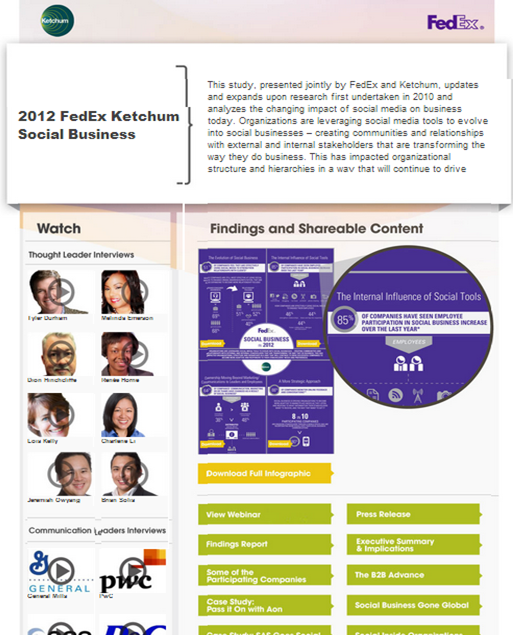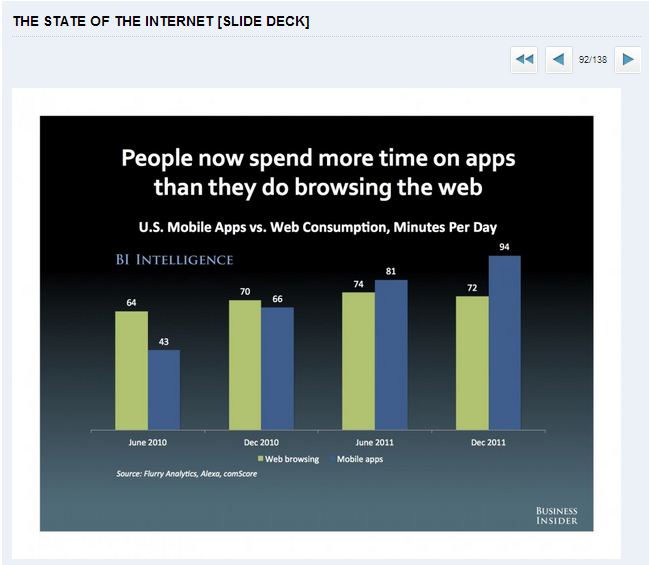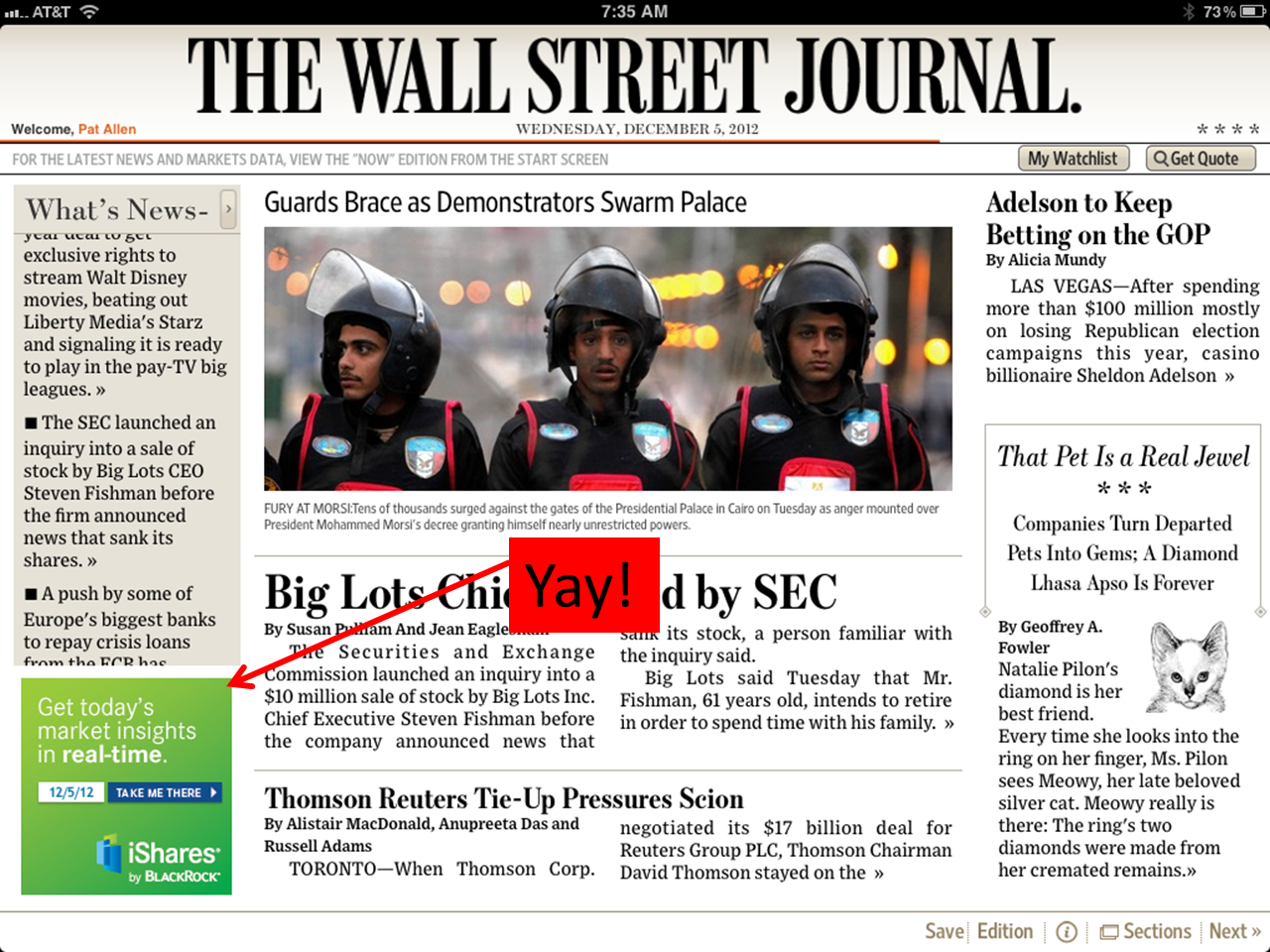20 Content Highlights To Remember From 2012
/ TweetI’ll never cease to marvel at the power of the written word. As just one recent example, I’m barely into Walter Isaacson’s Steve Jobs biography, and Jobs’ life path has already been influenced by articles that appeared in two magazines (one in Esquire and the other in Popular Mechanics).
Content (to include more than just the written word in 2012) can be just so relevant, so provocative, so entertaining that it has an impact on us. We email a link to it, we tweet about it, we mention it in real life conversations, we conduct research based on it, we remember it.
The following is a list of 20 content highlights that I’ll take from 2012. Notes I made to introduce the 2011 and 2010 lists apply here, too:
- Thank you to the dear tribes I interact with on Twitter, LinkedIn, Google+, YouTube, SlideShare, Pinterest and a little bit of Facebook for introducing me to most of the items on this list. Your curation enriches my life!
- This is probably not “the best content of 2012.” How could I make that claim? What follows is a motley mix, reflecting a broad interest in digital marketing effectiveness, a business focused on mutual fund and exchange-traded fund (ETF) marketing and a weakness for online distraction. In other words, this list is 100% subjective and X percentage quirky.
Here’s hoping you’ll discover something memorable, too.
1. Nobody Puts Baby In The Corner
iShares, Putnam and MFS are just a few of the asset managers who in 2012 bought high-rent advertising space and filled it with promotions of their market and investment product content. That’s right, this year the steak became the sizzle.
This frequent iShares ad on the home page of the The Wall Street Journal iPad app also suggests how high the stakes are nowadays—nobody's buying advertising to promote quarterly updates. The pressure is on to communicate in real-time, baby.
2. From The Victor Comes The Data
Competition in the future will be heavily data-based. And, in 2013, the campaign to re-elect President Obama and the data team behind it will be invoked repeatedly as a best practice approach. No more than one day after the election (the article was prepared ahead of time, with release embargoed), Time published this must-read: Inside the Secret World of the Data Crunchers Who Helped Obama Win.
3. Dear B2C: Thanks!
This post had me at the headline: Dear B2B, It’s Totally OK To Copy Our Outfits, Love, B2C, and the three-rule makeover for B2B content marketers, including examples, did not disappoint.
4. In A World Full of Average…
Big Content (which I take as a play on Big Data) is content that goes beyond individual one-off postings. Think of it as ambitious content, as you'll see in the examples cited in this SEOmoz blog post by Dr. Peter J. Meyers.
Online readers have become accustomed to landing on a page and seeing some text and probably a graphic. But increasingly in 2012 we saw examples of pull-out-all-the-stops content displays. Invariably, big content takes more effort and time but the benefits can be many-fold, as Meyers notes.
To cite an example I bookmarked this year, here's a screenshot from the 2012 FedEx Ketchum Social Business Study. Imagine the user’s delight at all there was to see—video, Webinar, case studies, social accounts—when he or she landed on this page. Compared to this, simply issuing a press release to report research results seems puny, doesn't it?

5. An Homage To The People Who Made It All Possible
Can you say “learning curve”?
As described in a richly illustrated Ars Technica article Make mainframes, not war: how Mad Men sold computers in the 1960s and 1970s, we have earlier generations of marketers to thank for their effective education of buyers on the features and benefits of computers. This account is one great read.

http://www.computerhistory.org/
6. Hard To See In the Dark
An important idea was advanced this year that we can’t see as much as we think we can about online activity.

Facebook and other social sites have structured the social Web but they did not create it and are not the only sources of link-sharing, says this October article from the Atlantic. Senior editor Alexis C. Madrigal notes the early and continuing popularity of chat rooms, message boards and email, all of which make up what he calls “dark social:” “a vast trove of social traffic that’s invisible to analytics programs.”
This is an especially relevant point for asset management marketers whose firms and offerings are regularly discussed in online forums and message boards. Related: In May, an SEO specialist made a distinction between Bright Websearch, which is search using the search giants, and Dark Websearch, which occurs on specialized search indexes outside Google, Bing, etc. (example: Websites’ product search). Dark Websearch is used more often but “no one is counting the queries or the clicks, the users or the referrals,” writes Michael Martinez in his SEO Theory blog post.
7. Sugar-coating Was So 2011
When you’re a straight-shooter, sometimes all you need is 140 characters, as shown in this @Vanguard_FA tweet.
Our Advisors app for iPad product comparison tool was too slow. We fixed it. Try it now. vgi.vg/RK9ICd
— Vanguard (@Vanguard_FA) November 17, 2012
8. When The Content Needs To Be 'Liquid'
I’m bending the rules here to include a 2011 video because it provides the content strategy rationale for a step that Coca-Cola took just last month: It made over its corporate Website as an online magazine called Coca-Cola Journey (here's the New York Times coverage).
Some of this is a little thick—I’m on board with the importance of data but stop short of considering data whisperers "the new messiahs.” Watch this and a second video for 15 minutes of insight into how this leading consumer brand approaches its re-thinking of content and testing.
9. Brands Bring It
Perhaps aided by their interactions on social networks, communications from asset managers are getting less formal. But they're still a mile or two away from this September AdWeek report of two brands acting like people this year.
Evidently, an Oreo Twitter team raised the possibility that people snuck Oreos into a movie theater. The @AMCTheatres account, which just happened to be paying attention, took exception and the game was on—two unconnected brands being playful with each other for the whole world to see. Love it, and you'll enjoy the entire article.

10. You Can Run But You Cannot Hide
Business’ heightened focus on data in turns heightens expectations about marketers’ command of data. Check out the Chief Marketing Technologist’s review of what Harvard Business Review thinks you should know. Blogger Scott Brinker has some recommendations on how to build your data savviness, and be sure to read the comments, too.
11. How An Investment Banker Sizes It All Up
On your own you could piece together most of what’s in here but don't bother—this report about the social media ecosystem, including the “Rise of Users, Intelligence and Operating Systems” is quite comprehensive and insightful. It was developed by Jordan, Edmiston’s Group Social Media Practice, the first of its kind for an investment bank, and supported by the Interactive Advertising Bureau.

12. Rule #2 In Improv: “Yes and…”
Columbia Management this year demonstrated that it’s willing to chime in on conversations already in progress. (That’s a characteristic of a social business and something I blogged about in March when financial advisor Jeff Rose started a Roth IRA movement.)
Last year, noted equities analyst Mary Meeker wrote a 450-page report called USA Inc. In April of this year, two Columbia portfolio managers based their own report, “USA Inc. — If it were a stock, would it be a buy, hold or sell?” on Meeker’s work. It demonstrates that not every good idea needs to originate within the firm. When you think about it, most don't.
13. Replacing Lines Of Code With Lines Of Dialogue
If there was any doubt that 2012 was the year of the story, it was dispelled in the 50th week of the year. Google (not known for conceptual marketing) last week posted a few videos that aimed to demonstrate how “missteps on the digital shelf play out in real life.” Here’s my favorite of the three.
14. Keep Up, Would You?
This isn’t for everybody but if you’re an information hound who suspects you could be more efficient with your news-catching, read this step-by-step guest post by Druce Vertes on TheReformedBroker’s blog. Awesome and generous.

15. Enabling Advisors
I cheered Putnam Investments’ September launch of AdvisorTechTips.com as an example of a content offering focused on the client. It’s a blog designed to help advisors learn and adopt online technology. The content and design are contemporary, although it could probably benefit from some user and guest post (FPPad’s Bill Winterberg would be a natural) participation, not to mention ongoing promotion.

16. The Ditty That Would Not Quitty (sorry)
The tune to Call Me Maybe has not been far from my consciousness since March when my niece came home from college obsessed with it. This Journalism.org article from June reconstructs its development as an Internet meme.
The song itself is the best 2012 example of creating content and setting it free. Canadian artist Carly Rae Jepsen may have recorded the song but she was just one of countless celebrities and non-celebrities we saw performing it on YouTube.
You'd be disappointed in me if I told you how many renditions I've sampled. My favorite is the Olympics Swimming team's. It was great to see those young athletes, who miss out on so much to focus on their sport, cutting loose, yukking it up and taking part. USA! USA!
17. Lots Of Progress To Report On
Business Insider’s CEO and editor-in-chief Henry Blodget likes to use slideshows to tell stories. While I understand their time-on-site-lengthening appeal to online publishers, slideshows aren’t my favorite content format. But anyhoo, Blodget’s 138-slide State of the Internet, released in October, is worth clicking through for a fast-paced briefing.

18. Ross Could Do The Paleontology On The Side
Who doesn't know Chandler and the gang from the Friends sitcom? Assuming your home is not in a cave, I think you'll get something out of this genius blog post assigning Friends personas to marketing team members. Blogger Oli Gardner had some valid points to make. By making the extra effort of writing in an entertaining way, he produced an indescribably satisfying post to read and share.

19. Remember Being Bored?
There’s no reason to be bored ever again now that we have the Internet. But…if you have any nostalgia about being bored or about reading as a “momentary stay against confusion” vs. reading to find something to share socially, check this April 2012 piece out. How We Will Read is a Q&A with Clay Shirky, a smart academic whose specialization is the evolution of the Internet culture.
20. Mobile Matters
Don’t make the mistake I did. Because I was walking as I was listening to a podcast of Shel Holtz’s 2012 IABC World Conference presentation, I needed to stop every few minutes to jot notes on my phone.
Much better for you to set aside an hour and give Holtz’s Game Changer: Mobility, Games and Gamification for the Communications Profession vision, via the slides and audio, the attention it deserves.




